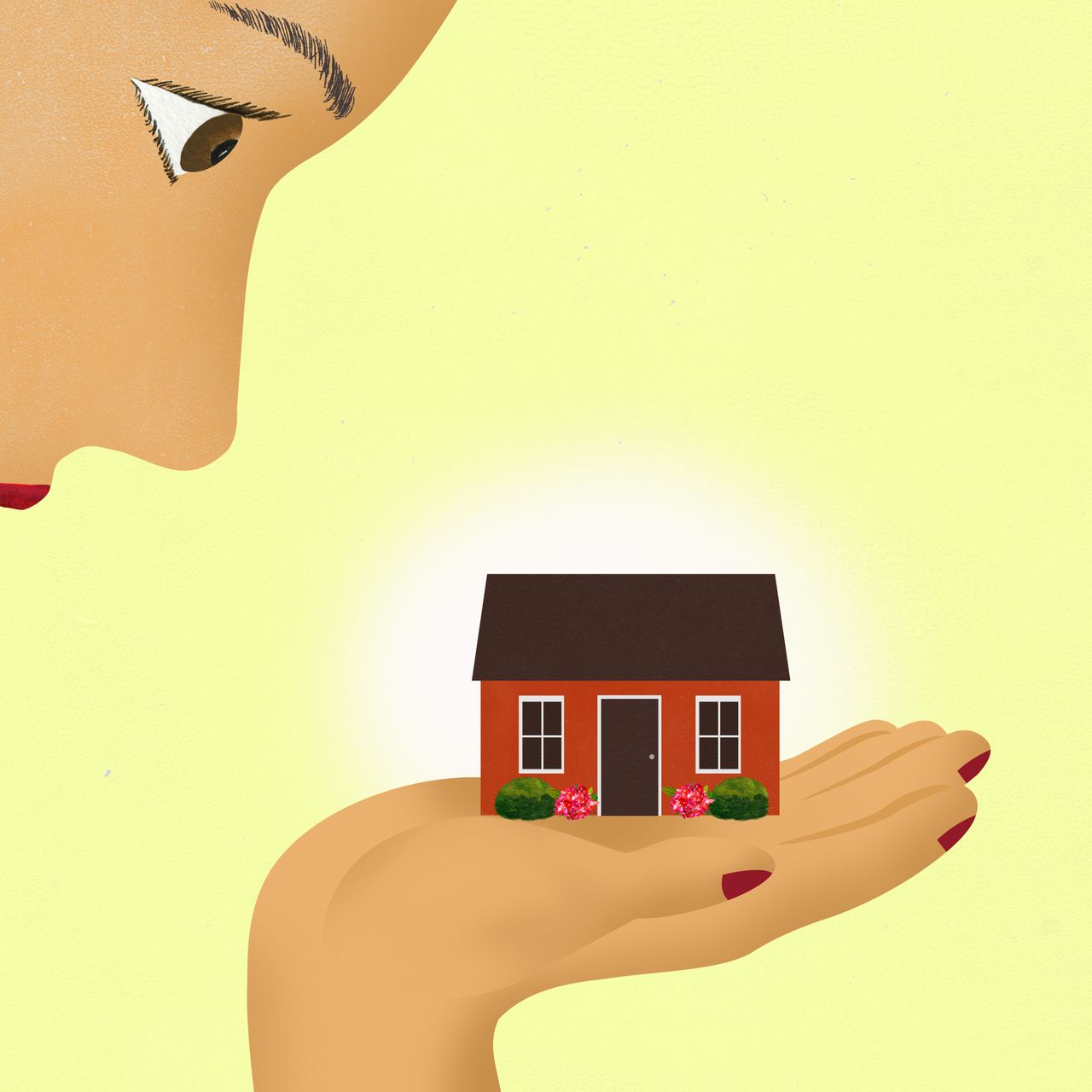Goodbye Bathtub and Living Room. America’s Homes Are Shrinking.
Faced with high mortgage rates, cost-constrained Americans are embracing smaller homes
For many Americans, homeownership may be attainable only if they give up a dining room.
Home prices are near record highs, frustrating millions of potential buyers who feel priced out of the housing market. Home builders are having to find ways to make their product more affordable to increase their pool of customers.
Shrinking the size of a new single-family home is an increasingly popular way to do it. Smaller homes can help cost-constrained buyers facing high mortgage rates. They also boost the bottom line for builders who are contending with spiralling labour and construction costs.
Since 2018, the average unit size for new housing starts has decreased 10% nationally to 2,420 square feet, according to Livabl by Zonda, a listing platform for new construction homes. Construction starts for new single-family homes declined in 2022. But starts for homes with fewer than three bedrooms increased 9.5% over the same period, according to a Zillow report.
Home sizes are shrinking the most in some of the hotter markets of previous years. The Seattle area, where the size of newly built homes is 18% smaller than it was five years ago, tops the list. New homes in Charlotte, N.C., and San Antonio shrank by 14%, Livabl by Zonda said.
Most builders and architects follow the same basic playbook to produce tighter, more efficient living spaces. They are axing dining areas, bathtubs and separate living rooms. Secondary bedrooms and loft spaces are shrinking and sometimes disappearing.
At the same time, they are increasing the size of multiuse rooms like kitchens and great rooms. Shared spaces like bunk rooms and jack-and-jill bathrooms, which are located between and shared by two bedrooms, are on the rise. In some cases, the kitchen island has become the only eating area in the home.
Estridge Homes, a semi-custom new-home builder that operates near Indianapolis, recently launched a new neighbourhood concept with detached homes 300 to 500 square feet smaller and $50,000 to $75,000 cheaper than it typically builds.
The builder is slashing some bedrooms and bathrooms and trading some indoor living space for outdoor space. Lots in the neighbourhood are smaller too, but the builder is working with limited acreage by landscaping to create privacy.
Home buyers began moving in earlier this year, and demand has been strong from both entry-level buyers and empty-nesters.
Those two groups “are both big demographics,” said Clint Mitchell, chief executive at Estridge. “They kind of want the same thing.”
In December, Brad and Julie Redman downsized from their more-than 7,000 square-foot custom-built home to a 3,400 square-foot semi-custom model in Westfield, Ind., after their children left home.
Despite the smaller house and yard in a denser neighbourhood, the couple is happy with the decision. They gave up a formal dining area when they moved, but their new eating area easily converts to space for entertaining guests.
“We can use the same space for more than one thing,” Julie Redman said.
Shrinking homes are also beginning to reshape the furniture market. Companies like Bob’s Discount Furniture are creating designs suited to tighter spaces. Demand has increased for items with multiple functions, from kitchen islands with drawers and wine racks to sleeper sofas and smaller, drop-leaf dining tables, said Carol Glaser, executive vice president of merchandising at Bob’s Discount Furniture.
“If they are in smaller homes,” she said of her customers, “they need their furniture to work harder.”
Still, even smaller homes won’t make a big enough dent in the purchase price for most entry-level buyers or provide an answer to the nation’s severe housing shortage. Estridge’s semi-custom homes and townhomes, for example, still range in price between $400,000 and $800,000.
The share of new home projects priced below $400,000 has declined in nearly every major home-building metro since 2018, according to Livabl by Zonda. For entry-level buyers across the nation, the cost of owning a home increased 72% from February 2020 to May 2023, according to an analysis by John Burns Research and Consulting that estimates monthly payments, maintenance and other costs of ownership.
And the smaller floor plans usually mean that buyers are getting less space for their dollar. Lower list prices might make the overall price cheaper, but buyers are still paying more a square foot, according to the U.S. Census Bureau. Inflation-adjusted cost a square foot increased about 2.5% on average between 2012 and 2020. In both 2021 and 2022, it increased nearly 4%, according to John Burns Research and Consulting.
Builders have also ramped up activity for other cost-saving methods, like starting home construction off-site and building more attached homes. In Lexington, S.C., buyers are willing to share a wall with a neighbor when it saves thousands and makes homeownership more attainable.
Sonia Mendez, a real-estate agent in the area, said she has seen builders increase construction of 1,500 to 1,700 square-foot townhomes.
“They are being bought just as fast as the single family home,” Mendez said. “The first-time home buyers are excited. They don’t see a small home. They see it as a dream come true.”
 Copyright 2020, Dow Jones & Company, Inc. All Rights Reserved Worldwide. LEARN MORE
Copyright 2020, Dow Jones & Company, Inc. All Rights Reserved Worldwide. LEARN MORE
Chris Dixon, a partner who led the charge, says he has a ‘very long-term horizon’
Americans now think they need at least $1.25 million for retirement, a 20% increase from a year ago, according to a survey by Northwestern Mutual
Villa prices saw particularly strong growth, with capital values increasing by 33.4 percent year-on-year
Dubai’s real estate market showed strong performance in the second quarter of 2024, with notable increases across the residential, office, and retail sectors, according to a new ValuStrat real estate report for Q2 2024.
Villa prices experienced particularly strong growth, with capital values rising by 33.4 percent year-on-year.
Haider Tuaima, Director and Head of Real Estate Research at ValuStrat said: “The Dubai real estate market has shown impressive growth and resilience in recent months. The ValuStrat Price Index for Residential Capital Values increased by 6.4 percent quarterly and 28.2 percent annually, reaching 178.2 points.
“Despite severe flooding caused by record rainfalls in April, the quick and effective response from developers and authorities helped to control the damage, ensuring that market activity and property valuations remained robust in the subsequent months.”
The office sector also performed well, with the VPI for office capital values surging by 31.7 percent annually and 9.4 percent quarterly, reaching 212.5 points—the highest quarterly increase in a decade.
In the retail sector, Emaar Properties reported 98 percent occupancy in their prime mall assets, while overall mall occupancy stood at 96 percent during the first quarter of 2024. The hospitality sector also saw growth, with total international guests reaching 8.12 million as of May 2024, a 9.9 percent increase compared to the same period last year. Hotel occupancy reached 81 percent, rising by 1.4 percent year-on-year.
Despite these positive indicators, Tuaima added, “The decline in transaction volumes calls for a closer examination of market dynamics as stakeholders navigate this evolving landscape.”
Chris Dixon, a partner who led the charge, says he has a ‘very long-term horizon’
Americans now think they need at least $1.25 million for retirement, a 20% increase from a year ago, according to a survey by Northwestern Mutual





















